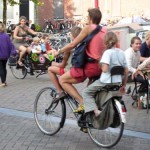 Denmark is a great example on effective use of public promotion instruments on renewable energy. And now we are not speaking merely about the effecitive use of manpower on transportation (bicycles account for 18 per cent of all trips taken in Denmark)!
Denmark is a great example on effective use of public promotion instruments on renewable energy. And now we are not speaking merely about the effecitive use of manpower on transportation (bicycles account for 18 per cent of all trips taken in Denmark)!
Oil crisis in 1970’s created a basis for Danish renewable energy production. In those days Denmark imported 99 per cent of all energy used. After 30 years, Denmark has enjoyed an economic growth ( GDP 56 per cent higher since 1980) with reduced CO2 (35 per cent lower since 1980). In 2004, Denmark has the lowest energy consumption per unit in EU countries.
The share of renewable energy of total production in 2004 was 30 per cent, which is among the highest in EU countries and gained without hydro power. Wind power provided almost 20 per cent of electricity in 2007, while biomass and waste represented the rest. Danish national goal for renewable energy is at least double to minimum 30 per cent of total gross energy consumption by 2025.
Denmark uses wide range economic incentives. Taxes and fees are used to affect the consumption of fossil fuels and renewable, and subsidies are used to increase bio-mass utilisation for electricity production and heat. (please look at Renewable Energy in Denmark by Danish Energy Agency)
Danish wind power industry possess around 40 per cent of the global market with a combined turnover of 3 billion euros with manufacturers. Danish wind power is a great success story altough public incentives have also been supported to biomass and solar collectors. The first projects in 1970’s began privately with public support on R&D. The first public grants, support for installations and advantageous feed-in prices introduced in 1980’s, increasing the development in large scale turbine development. The capital investment grant was revoked in 1990’s. Within few years wind power is expected to compete with fossil fuels without significant subisidies in Denmark (see a Fact Sheet by Danish Energy Authority).
Denmark started to decentralise heat and power production from centralised towards decentralised system. The point was to locate large number of minor plants all over the Country close to end-users to use heat in local District Heating system. Denmark has now more than 700 power plants with different technologies and systems. By using decentralised CHP system, Denmark has reduced fuel consumption by up to 30 per cent and increased the net efficiency of fuel significantly.
Danish government’s proactive trade strategy to promote Small and Medium Size Enterprises (in cleantech) export trade deserves a special attention. The Trade Council of Denmark (Danida) is the export and investment organization within the Danish Ministry of Foreign Affairs. The key task, clearly, is to promote trade and identify trade barriers and provide solutions to break them down. It has set very transparent strategic objectives, targets and follow-up indicators (please scroll down to page 3) for their operations. In 2006, even 96 per cent of enterprises were satisfied or very satisfied on Danida’s services. (I tried to catch benchmark figures of public organizations in other countries but didn’t find them..)




